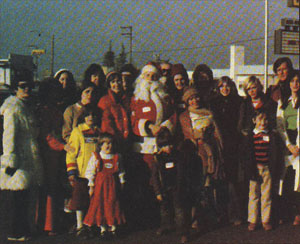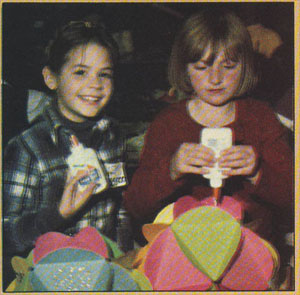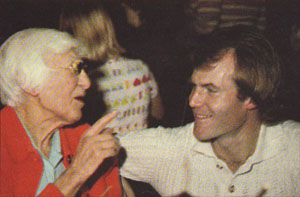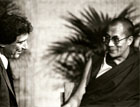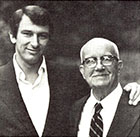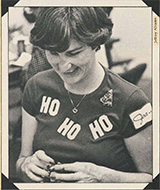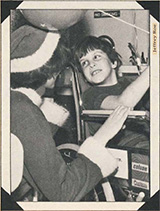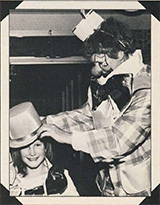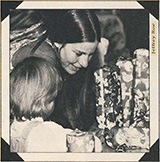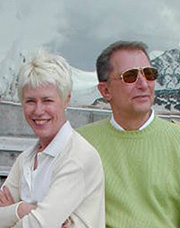
The Holiday Project |
|||||||||
The Holiday Project is an independent non-profit organization managed by volunteers nationwide. They continue to organize visits and gift-giving to people confined in hospitals, nursing homes, shelters, prisons, and other institutions during Christmas, Chanukah, and other holidays throughout the year.
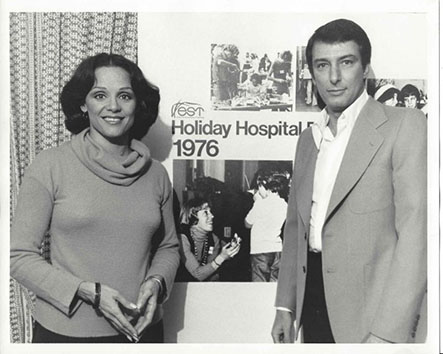
Werner Erhard and Valerie Harper, The Holiday Hospital Project The first Holiday Project Visit took place on Christmas Day in 1972. For the next seven years, more and more people, in communities all over the United States joined in what was then called The Holiday Hospital Project. In 1980, the Board of Directors registered as a 501(c)(3) non-profit called The Holiday Project. The Holiday Project continues to operate to this day. For information on how to participate see: http://www.holidayproject.info/wherewhen
The Holiday Project was featured in a national CBS news broadcast in December 2013:
Visit the national Holiday Project organization's website where you can find inspiring stories and participate in current Holiday Project activities. The Holiday Project began through the work of graduates of the est training. The first Holiday Project visit occurred on Christmas Day, 1972 in San Francisco, California. Since its incorporation as a non-profit public benefit organization in 1980, more than 180,000 volunteers from every social, and economic background visited more than 1,500,000 people around the United States. The real story of the Holiday Project lives in the lives of the experiences of each individual who participated. It lives in the face of an old man, beaming as a small child hugs him. It lives in the misty eyes of a woman recalling her youth. And it lives in the way the volunteers speak about their lives. "We gave gifts and sang, but the songs and gifts were just an excuse for us to be close" ... "Now every year I visit with The Holiday Project. It makes my holidays how I always want them to be." The Holiday Project also lives beyond the confines of the hospitial room or nursing home. It is embodied in the lives of the families and friends who participate year after year. Many say their experience of the holidays and of each other is more fulfilling and carries through into their day-to-day pursuits. As one volunteer put it "The Holiday Project is for all of us. The people we visit give us as much as we give them."
The Impact of The Holiday Project:"People from all over the country shared stories of happenings in their communities, happenings that brought tears and laughter to the room, happenings that gave reality to the word miracle. Someone told of a volunteer visiting a hospital in New York City, walking into a ward and standing beside the bed of a teenage girl who had overdosed on drugs on Christmas Eve. Suddenly the man bent down to look more closely, then cried out and took the girl in his arms. He'd recognized the sister who had run away from home two years earlier. Another told of a man, totally paralyzed by a stroke, who had been denied the financial help needed for equipment that would allow him to communicate, on the grounds that being able to communicate was not "medically necessary." For months he had been locked into a lonely world by himself. The group raised money, bought a computer and equipment that utilized the man's ability to slightly raise and lower his head (the only movement of which he was capable). A month after Christmas we recieved a letter - a letter that had been tapped out one key at a time on a computer, by a man with a wand attached to a headband. The letter said, 'Thank you. I'm back in touch with the world.'" - excerpted from "Reading Under The Covers," by Elizabeth Russell, former executive director of The Holiday Project Look Out, Scrooge! Here Come 90,000 Santas!It's an old-fashioned Christmas
and everyone can play. Create the
yuletide season, just the way you'd
like it, from scratch. Here's how it
works. Five years ago, Werner put together
the Holiday Hospital Project to
allow all est graduates the opportunity to participate in making tlie spirit of
Christmas come alive for children and
adults who might otherwise spend it
alone in places like hospitals and convalescent
homes. The purpose of the
project is not merely to drop off a gift
or two at this hospital or that convalescent
home, but actually, actively to
participate in creating and delivering a
whole, real, live Christmas to
thousands of people - and to share it
with them personally. Last year, as always, the Holiday
Hospital Project was organized, managed
and implemented almost entirely
by est graduate assistants. In six est cIties, 5,715 graduates donated more
than $16,000 to sponsor the project
and purchase gifts; and 2,400 more
graduates delivered those gifts to
nearly 13,000 patients in 128 hospitals
and homes during Hanukkah and
Christmas. The question, "Why assist?", came up, and one Holiday Hospital Project 'veteran" gave us her point of view: "I've volunteered my time and money to a number of charities and foundations over the years, and what appeals to me about the Holiday Hospital Project, where the value is for me, is that I don't come from helping. I know that whoever I'm communicating with is a totally capable being, regardless of age, temperament or degree of illness. And they get that. They get that I'm there to participate with them. That's where the joy and aliveness is exchanged, just being together. - From the Graduate Review, November, 1976
"A Pure Opportunity To Be With People"A child at Napa State Hospital in California looked up and said, "We couldn't go home, but I feel as if our families were here. You're bringing Christmas to us." He was talking to vIsitors from est's 1976 Holiday Hospital Project, and came close to summing up the feelings of everyone who participated in it. On Hanukkah and Christmas Day, est graduates took presents to 24,217 patients in 207 hospitals and convalescent homes across the United States - almost twice as many people, in this fifth year since Werner initiated the project, as they had visited in 1975. Derek Williams, coordinator of the project, reported that more than 11,000 graduates donated money and gifts, and 5,600 participated in buying, wrapping, and delivering the presents. Numbers are just one reflection of what
the est graduates and the patients shared. In
New York, a patient tells his visitors, "I was
feeling badly because I wasn't going to be
with my family. And when you walked in, I
realized you were my family." In Washington, D.C., Romaine Hill comes away empty-handed: "What comes up for me is
love. I notice that I don't have a lot of 'pity'
going on... I don't have to carry anything
out of the hospital with me." D.G. Gould
sums up later at the Christmas dinner in
Washington: "My visit to the hospital was a
pure opportunity to be with people. There was no other purpose in being there - nothing to win, lose, or sacrifIce." In acknowledging the support that est graduates gave the project, Werner said: "Thank you to each of you who participated in the Holiday Hospital Project,
whether you participated as a family, group,
couple, or single person. In the experience
and expressIon of your well-being,
you have supported the aliveness of
others. This is an expression of self
as context transformed from self as
object or thing. This is true self expression.
Thank you for being
A Beautiful Holiday"There has never been a more beautiful Christmas." That was the consensus among graduates and their friends who participated in the 1977 Holiday Hospital Project. The project has continued to grow in the six years since Werner Erhard initiated it: This year, more than 18,000 people participated in 46 cities, by sending in donations ($46,631), by buying and wrapping gifts, and by delivering gifts to 43,000 patients in hospitals and convalescent homes on Christmas and Hannukkah. In thanking the graduates who participated in the project, Werner said, "The real gifts you give are the love and joy you express, the relatedness you share as 'family,' and the place you come from that each of us matters in the world. It's clear that we are in partnership in creating the world working. Your graciousness and humanity are inspiring." - From the Graduate Review, February, 1978
Holiday Hospital Project Reaches Out To 110,000 People
|
|
In 1988 Werner Erhard was presented the Mahatma Gandhi Humanitarian Award: “In honor of your notable effort to end the starvation and hunger suffered by millions throughout the world and for drawing broad public awareness to the value of integrity in our everyday lives.”
Werner Erhard and Gonneke Spits
|
||
